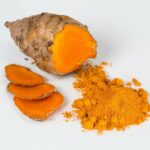Did you know the use of turmeric dates back to 4000 years ago in India?
It was used as a culinary spice and also had religious relevance.
The journey took off and spread worldwide till today, where it’s a common spice worldwide.
Turmeric is known for its medicinal and anti-inflammatory properties in humans, but is it the same for dogs?
Can dogs eat turmeric?
Yes, dogs can have turmeric, so they can benefit from its several benefits, such as relieving joint pains.
Curcumin, the main turmeric compound, is an antioxidant that helps the dog treat and prevent different ailments.
There are a few culinary spices that carry similar health benefits for humans and dogs, and turmeric is one of them.
Read on and find out how your pup stands to gain by feeding on turmeric.

What Benefits Does Turmeric Have on My Dog?
Over the last few years, dog owners have shown a strong bias toward turmeric, and the surge in interest can only be attributed to its benefits for dogs.
Here are the main benefits that turmeric has on dogs:
Anti-Inflammatory Properties
Any veteran dog owner will tell you they have struggled with inflammation on their dogs at one point.
Inflammation is a common feature of dogs, and it doesn’t have to be for dogs with joint issues.
No, any dog can have an inflammation problem.
Curcumin, a turmeric compound, helps reduce inflammation in dogs.
Inflammation is not limited to arthritis; in reality, it’s a dog’s response to toxins or infection, meaning it can stem from different sources.
Turmeric helps numb the pain and swelling that comes with the different infections.
Feeding your dog meals with turmeric will lower the levels of inflammation that it may experience in the event of an infection or injury.
Turmeric reduces inflammation by inhibiting the molecules responsible for the pain.
Boosts Your Dog’s Heart Health
Turmeric is famed for having blood-thinning properties that help blood flow within the dog’s cardiovascular system.
Blood clots in dogs pose a great danger to your dog, and the impact could even be life-threatening.
Constantly feeding your dog turmeric means your dog has a healthy flow in and out of the system lowering the chances of heart disease for your pup.
Improves Mobility and Balance
Turmeric comes in handy, especially if your dog is elderly, as it will boost its bones and joints, aiding in easy movement.
As dogs grow old, they find it challenging to move around, and their balance and joints are weakened.
To ease their pain, boost mobility and balance, feed the dog meals with turmeric, and you’ll have made life in their golden years bearable.
Antioxidant
Among turmerics’ many benefits, its antioxidative properties top the list.
Antioxidants are critical in helping the dog’s body fight the free radicals responsible for various ailments.
The dangerous free radicals in a dog can lead to heart ailments, cancer, poor vision and arthritis.
Like most ailments, these too can be prevented by a proper diet, have your dog benefit from the antioxidative properties of turmeric from a tender age to keep these infections at bay.
Improves Gut Health
Turmeric anti oxidant features make it a remedy for most gut infections.
If your dog has an acidity problem, you can have it on turmeric; you’ll have solved the problem.
The digestive system benefits from turmeric by allowing the entire process to flow smoothly, from ingestion to defecation.
Gastrointestinal issues are common in dogs, most of which stem from what you feed the pup.
To limit these health issues, have the dog meals laced with turmeric.

How to Feed Turmeric to Dogs
There are several ways you can share turmeric with your dog to ensure they reap the most benefits.
Giving turmeric to your dog directly through the mouth is challenging as the dog may not cooperate, and its absorption in the body is poor.
Here are the different ways you can give turmeric to your dog:
Paste
You can make a paste containing a high percentage of organic turmeric, then add some oil and water to make a thick paste.
Heat for about ten minutes on low heat, and allow to cool.
Most people prefer storing for around two weeks in the refrigerator before sharing.
Add the paste to your dog’s meals, so it becomes easy for the dog to ingest.
Gravy
This is easier to make and takes lesser time.
It’s a convenient method of sharing the turmeric, especially when you only have a limited supply that you can’t afford to have in the refrigerator for an entire week.
Add a spoon of turmeric powder to boiling water and coconut or olive oil.
You have the option to add pepper to the mix.
Allow the mixture to cool a few minutes before sharing.
Add it as an Ingredient
If you don’t have the resources or time for the other two when prepping your dog’s meal, you can add it, and it will work just fine.
Add healthy oils and black pepper for optimal results and total absorption within the dog’s body.
This is not the best way, but it will serve the purpose.
What is the Right Turmeric Dosage for Dogs

The right amount varies and is influenced by several factors, including size, age and health predisposition.
Avoid giving turmeric to dogs with these health conditions:
Kidney infections
Pregnant dogs
Dog taking blood-thinning meds
Gallstones
Conclusion
Turmeric can be termed magical, given the many benefits it has on dogs.
It’s always your duty as a dog owner to monitor the pup’s diet.
Feeding your dog turmeric is one way to keep ailments at bay and have a healthy, happy pup, as was your goal.
Right?
- What Dog Breeds Have Pink Skin? - March 24, 2023
- What Are the Most Inspiring Dog Breeding Quotes? - March 20, 2023
- Can Pheromone Spray Help Improve Dog Breeding Results? - March 19, 2023








